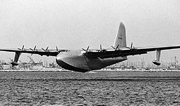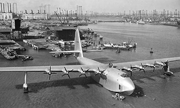E-Archive
Off the Beaten Track
in Vol. 12 - March Issue - Year 2011
The Spruce Goose


“A flying lumberyard!”, sneered his critics during the public hearings which started in August 1947. The forty-two year old man had been summoned to the U.S. Senate to justify his use of government funds for a project that should have been completed three years earlier, but which continued to drain money without producing any tangible result. As he intently followed the debate, Howard Hughes found it harder and harder to suppress his irritation and frustration. The few minutes during which he was allowed to speak were followed by endless interventions on the part of his detractors, determined to prove his incompetence and bad faith. He had to do something, anything, to prove his critics wrong. But what?
******
In 1942, the U.S. War Department issued a tender for the design and construction of a transport plane to carry troops and war materiel to Europe. Transportation by air was the only way to avoid attacks by enemy submarines, which had been inflicting heavy losses on shipping convoys. The tender specifications called for a flying boat design with the greatest possible payload and to be built with little or no metal, due to wartime limitations on the use of strategic materials such as steel and aluminum. Practically speaking, the new aircraft had to be made almost entirely of wood!
The challenge was taken up by a steelmaker named Henry Kaiser, who was already involved in the war effort by overseeing the Liberty ship construction program. Although Kaiser came up with the original concept of the aircraft, he soon realized that he did not know enough about aircraft design to follow through with the project. This prompted him to team up with Howard Hughes, an aircraft enthusiast and multimillionaire who had inherited a fortune in the oil drilling tool business. Hughes had set up his own aircraft company in 1932 and had already set some speed and distance flying records when he was approached by Kaiser.
Hughes soon became totally absorbed with the project and put his team of engineers to work on what was to become a behemoth and something never seen before, or since, in the aircraft industry. His creation, named the H-4 Hercules, was an aircraft which is the largest flying boat ever built and with the largest wingspan of any aircraft in history. The numbers are amazing: the plane was 67 meters long and 24 meters high, with a wingspan of 98 meters! By comparison, a modern Airbus A380 has a wingspan of 80 meters, while the world’s biggest aircraft now flying, the Antonov An-225, has a wingspan of 88 meters. The H-4 Hercules was powered by eight Pratt & Whitney radial engines, each delivering 4,000 horsepower and mounted with four-bladed propellers with a diameter of over five meters. Most impressively, the aircraft’s structure was made almost entirely of wood, earning it the nickname of “Spruce Goose”, although the type of wood which was actually used was birch and not spruce. To further limit the use of metals, even the plane’s elevators and rudder were fabric-covered.
However, Hughes was a perfectionist. His obsession with detail and his insistence on micromanaging every small detail caused huge delays in the project and led Henry Kaiser to withdraw from the partnership before a flying model was actually built. The H-4 was completed after the war was over and Hughes was summoned to Washington to answer accusations of misusing government funds.
Hughes took advantage of a recess in the Senate hearings in November 1947 and returned to California, where the H-4 was harbored, to run further engine and taxiing tests. On the last of these runs, Hughes, sitting at the controls, unexpectedly turned the nose of the plane towards the open sea and pushed the engine throttles full forward. The flying boat lifted into the air and remained aloft at an altitude of about twenty meters, covering a distance of almost two kilometers before Hughes brought it back down gently on the surface of the water. This was to be the first and only flight of the Spruce Goose.
Critics later claimed that, at such a low altitude, the aircraft still benefited from the wing-in-ground effect and that consequently its capacity to sustain flight at a cruising altitude was never demonstrated. Nevertheless, the H-4’s short flight was enough to vindicate Hughes and to have all accusations against him dropped.
By Giovanni Gregorat, Contributing Editor MFN & Sales Manager, Pometon Abrasives
Author: Giovanni Gregorat



























